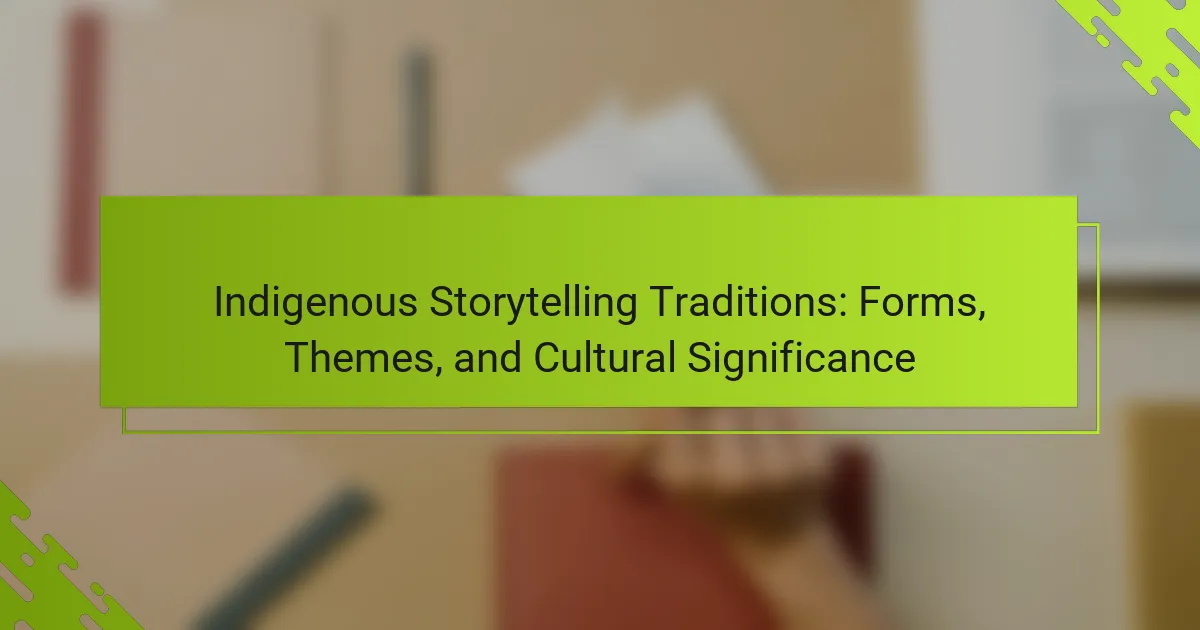Indigenous storytelling traditions are vital for preserving cultural identity and history. This article explores various forms of storytelling, key themes, and their cultural significance. It also addresses the challenges these traditions face in the modern world and highlights methods for preserving and sharing them effectively. Understanding these narratives fosters appreciation for diverse perspectives and community values.
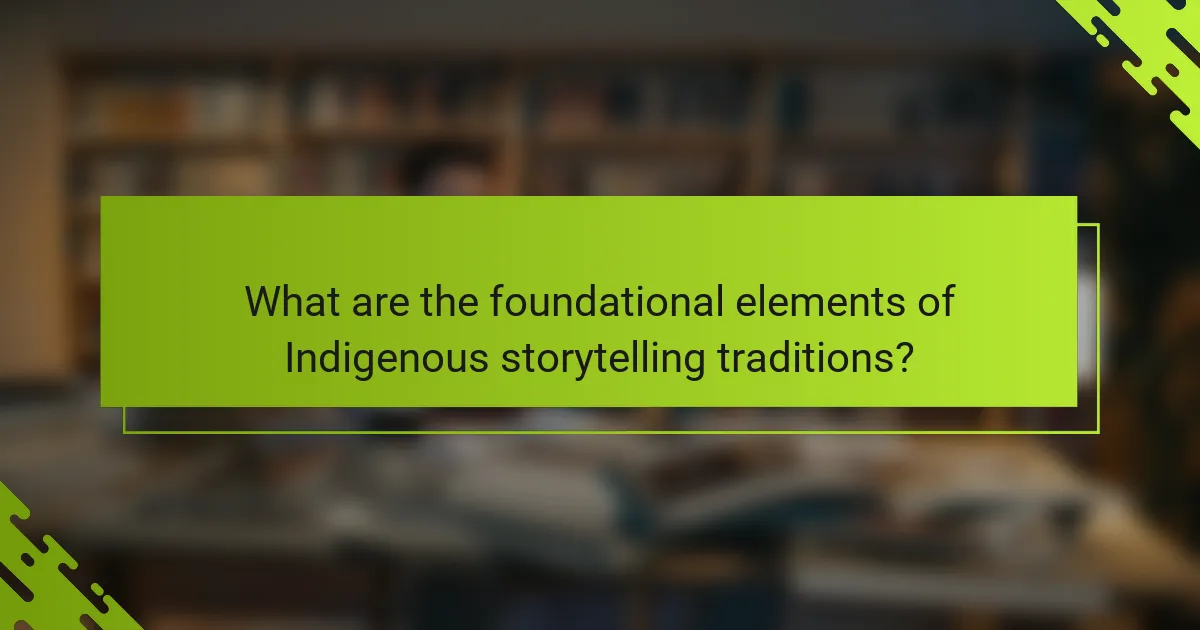
What are the foundational elements of Indigenous storytelling traditions?
Indigenous storytelling traditions are rooted in oral history, cultural identity, and communal values. These traditions encompass various forms, including myths, legends, and songs, which convey lessons and cultural significance. Key elements include the use of symbolism, connection to nature, and the role of the storyteller as a cultural custodian. Themes often reflect community values, ancestral knowledge, and the relationship between people and the land. Through these narratives, Indigenous cultures preserve history and foster a sense of belonging.
How do oral traditions shape cultural identity?
Oral traditions shape cultural identity by preserving history, values, and beliefs through storytelling. Indigenous storytelling traditions serve as a vital means of cultural transmission, connecting generations and reinforcing community bonds. These narratives often feature unique attributes such as ancestral teachings and moral lessons, which are essential for maintaining cultural continuity. Additionally, themes like nature, spirituality, and community resilience frequently emerge in these stories, reflecting the collective identity of the group. As a result, oral traditions play a crucial role in shaping and sustaining the cultural identity of Indigenous peoples.
What role do nature and the environment play in storytelling?
Nature and the environment are central to Indigenous storytelling traditions, serving as vital backdrops and characters. These narratives often reflect the relationship between people and their surroundings, emphasizing themes of harmony and respect. For instance, many stories illustrate the interconnectedness of all living beings, showcasing how nature influences cultural identity and values. The landscapes, animals, and plants depicted in these stories carry unique attributes that convey lessons and cultural significance, reinforcing the importance of environmental stewardship. This deep connection between storytelling and the environment fosters a sense of belonging and responsibility within Indigenous communities.
Which common themes emerge across different Indigenous cultures?
Common themes across different Indigenous cultures include connection to nature, oral traditions, spirituality, community values, and resilience. These themes reflect shared values and experiences that shape their storytelling traditions.
Indigenous storytelling often emphasizes the relationship between people and the land, portraying nature as a living entity. Oral traditions serve to preserve history and cultural identity, passing knowledge through generations. Spirituality is a central element, with stories often conveying moral lessons and connections to ancestors.
Community values are highlighted in narratives that prioritize collective well-being over individualism. Resilience appears in stories that recount survival, adaptation, and the strength of Indigenous peoples in the face of challenges. These themes collectively underscore the significance of storytelling in fostering cultural continuity and identity.
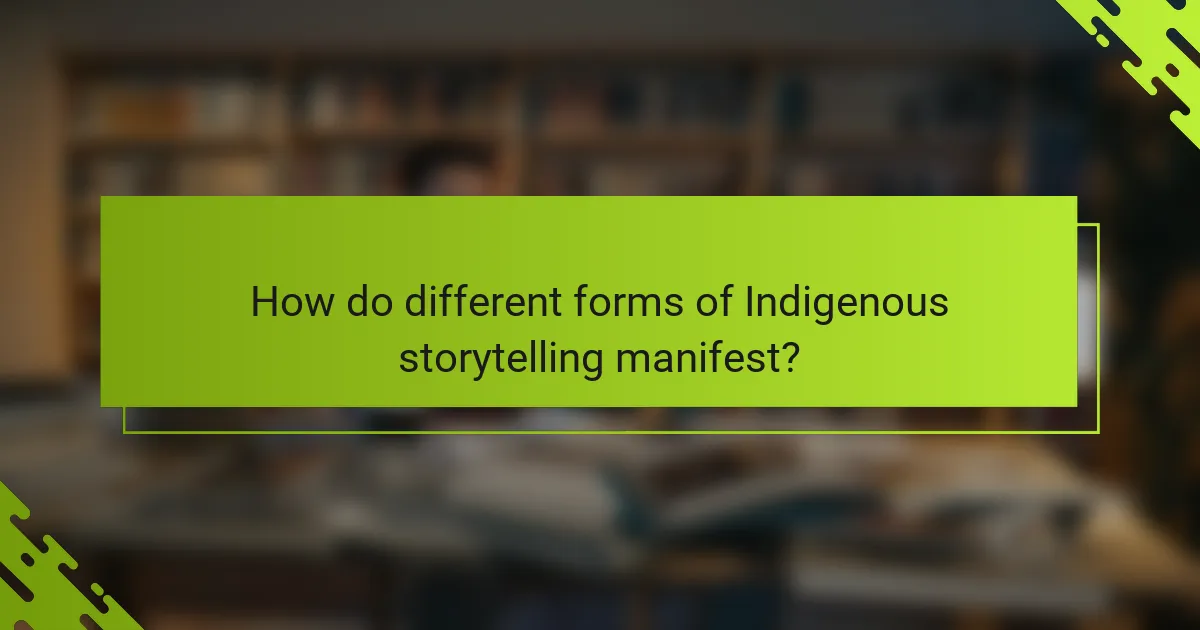
How do different forms of Indigenous storytelling manifest?
Indigenous storytelling manifests through oral traditions, visual arts, and performance. These forms convey cultural values, history, and identity. Oral storytelling often employs metaphors and folklore, while visual arts utilize symbols and motifs. Performance integrates dance and music, enhancing communal experiences. Each form serves to preserve and transmit knowledge across generations.
What are the various narrative styles used in storytelling?
Indigenous storytelling traditions utilize various narrative styles that reflect cultural significance. These styles include oral traditions, which emphasize communal sharing, and mythological narratives that convey spiritual beliefs. Other forms include personal stories that connect individual experiences to broader themes and allegories that impart moral lessons. Each style enriches the cultural tapestry, preserving history and fostering community identity.
How is visual storytelling integrated with oral traditions?
Visual storytelling is deeply integrated with oral traditions, enhancing narrative depth and cultural retention. Indigenous storytelling often employs visual elements, such as art and symbols, to complement spoken narratives. This fusion enriches the storytelling experience, making themes more relatable and memorable. For instance, visual motifs can represent key cultural values and historical events, reinforcing the oral message. The synergy of visuals and oral traditions preserves cultural identities and fosters community connections across generations.
Which contemporary adaptations are seen in Indigenous storytelling?
Contemporary adaptations of Indigenous storytelling incorporate modern mediums, themes, and perspectives. These adaptations utilize film, literature, and digital platforms to reach wider audiences. They often emphasize themes of identity, resilience, and cultural preservation. Unique attributes include the blending of traditional narratives with contemporary issues, such as environmentalism and social justice. For example, filmmakers and authors are reinterpreting age-old stories to reflect current societal challenges, enhancing their relevance. These adaptations highlight the dynamic nature of Indigenous storytelling, ensuring its continued significance in modern culture.
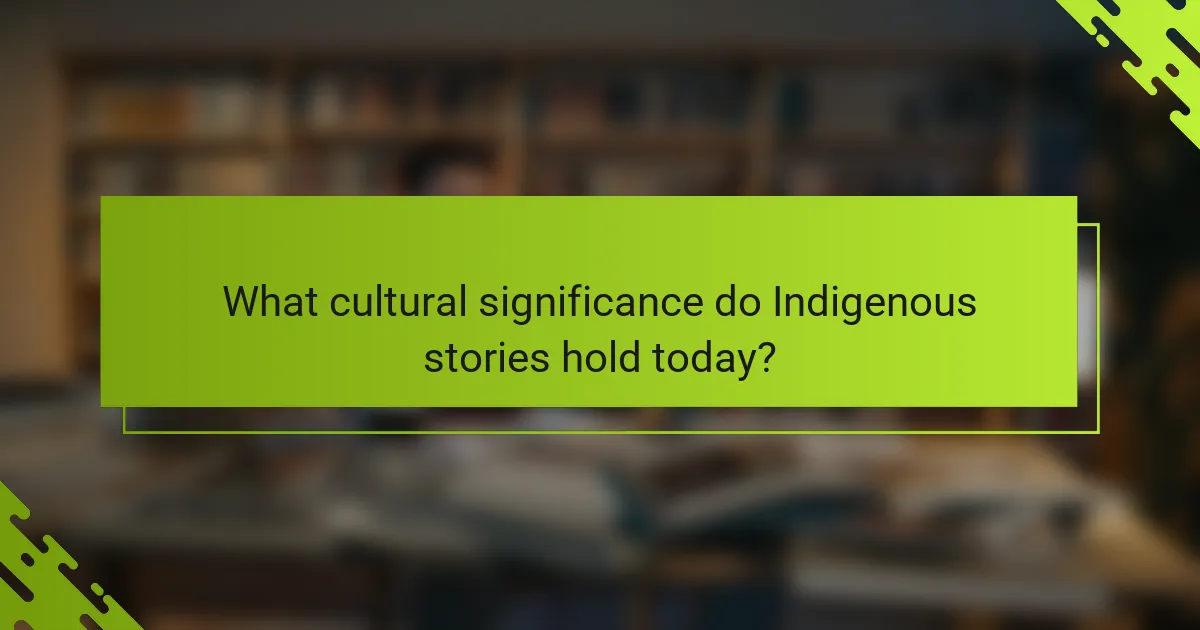
What cultural significance do Indigenous stories hold today?
Indigenous stories hold significant cultural importance today as they preserve history, identity, and values. These narratives convey lessons, morals, and traditions, fostering community cohesion. They connect generations, ensuring the transmission of knowledge and cultural practices. Additionally, Indigenous storytelling promotes awareness and appreciation of diverse perspectives in contemporary society.
How do stories serve as a means of preserving history?
Stories serve as a vital means of preserving history by transmitting cultural knowledge and values through generations. Indigenous storytelling traditions encapsulate historical events, social norms, and spiritual beliefs, ensuring their survival. These narratives often employ oral forms, such as songs and legends, which are rich in themes of identity, community, and resilience. As a result, they not only document the past but also strengthen cultural ties and foster a sense of belonging among Indigenous peoples.
What impact do Indigenous stories have on community cohesion?
Indigenous stories significantly enhance community cohesion by fostering shared identity and cultural continuity. These narratives often encapsulate communal values, histories, and teachings, reinforcing social bonds. For example, storytelling events bring community members together, promoting dialogue and mutual understanding. This practice also preserves unique cultural attributes, such as language and traditions, which are vital for the community’s identity. As a result, these stories play a crucial role in maintaining social harmony and resilience within Indigenous communities.
How do storytelling traditions influence modern Indigenous art and literature?
Indigenous storytelling traditions significantly shape modern Indigenous art and literature by preserving cultural identity and conveying historical narratives. These traditions emphasize oral history, symbolism, and community values, which influence contemporary themes and artistic expressions.
For example, the use of storytelling in visual arts often incorporates traditional motifs and narratives, creating a dialogue between past and present. Themes of resilience, connection to the land, and spirituality are prevalent, reflecting the unique cultural attributes of various Indigenous groups.
As a result, modern works often serve as a platform for cultural revitalization, fostering a deeper understanding of Indigenous perspectives. This integration of storytelling into art and literature highlights the ongoing relevance and significance of Indigenous traditions in contemporary society.

Which unique attributes distinguish specific Indigenous storytelling practices?
Unique attributes that distinguish specific Indigenous storytelling practices include the integration of oral tradition, connection to land, and the use of symbolism. Oral tradition emphasizes storytelling as a communal experience, fostering cultural continuity. Connection to land reflects the deep relationship between stories and the environment, often conveying lessons about nature. Symbolism conveys complex ideas through metaphors and imagery unique to each culture, enriching the narrative. These attributes contribute to the distinctiveness and cultural significance of Indigenous storytelling traditions.
What are the distinctive features of storytelling in particular Indigenous groups?
Indigenous storytelling traditions are characterized by unique features that reflect their cultural heritage. These narratives often emphasize oral transmission, communal participation, and deep connections to the land.
Distinctive forms include myths, legends, and songs, which serve to teach moral lessons, preserve history, and explain natural phenomena. Themes frequently revolve around nature, spirituality, and community values, showcasing the interconnectedness of life.
Cultural significance lies in the role of storytelling as a means of identity preservation and cultural continuity. It fosters community bonds and imparts wisdom across generations. Unique attributes of these traditions can vary widely among different Indigenous groups, reflecting their specific histories and environments.
How do regional variations affect storytelling techniques?
Regional variations significantly influence storytelling techniques in Indigenous traditions. These variations shape narrative structures, themes, and performance styles, reflecting the distinct cultural contexts of each community. For instance, oral traditions may emphasize local landscapes or historical events, embedding them within the storytelling framework.
Moreover, the use of language and dialects can alter the emotional resonance of stories, creating unique connections with audiences. Certain regions may prioritize collective memory and communal identity, integrating these elements into storytelling practices. These adaptations highlight the importance of place and experience in shaping Indigenous narratives, ensuring they remain relevant and impactful across generations.
In summary, regional variations enrich Indigenous storytelling by fostering diverse expressions of culture and identity, ultimately enhancing the significance of the narratives shared within those communities.
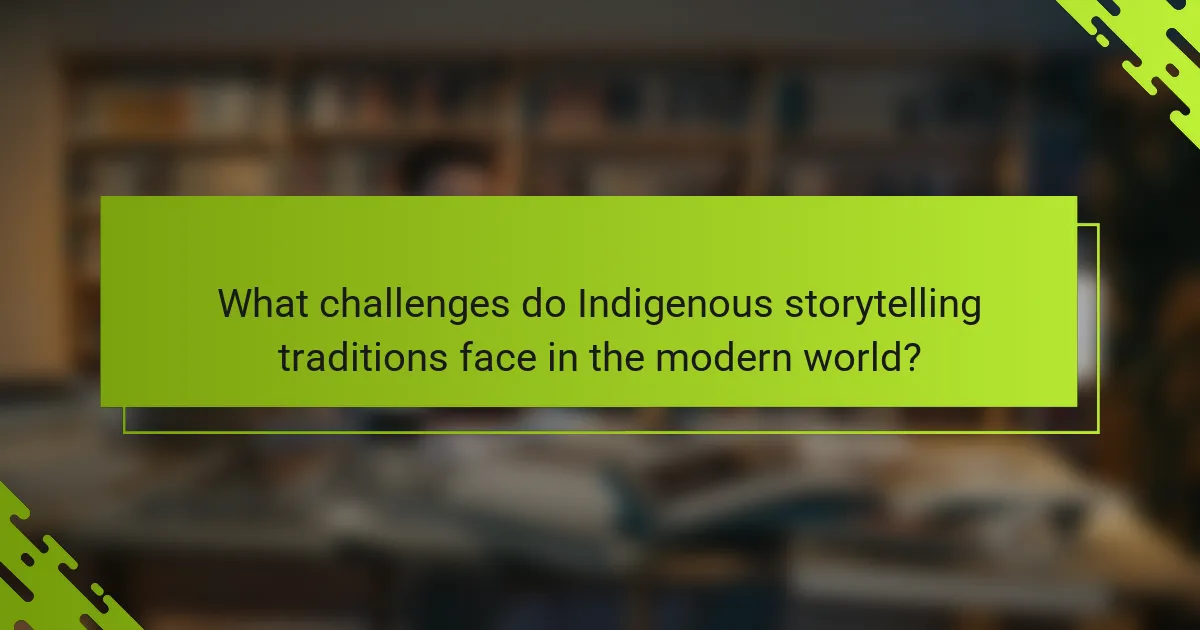
What challenges do Indigenous storytelling traditions face in the modern world?
Indigenous storytelling traditions face significant challenges in the modern world, including cultural erosion, commercialization, and misrepresentation. These challenges threaten the authenticity and transmission of oral histories. The impact of globalization often leads to dilution of traditional narratives, while digital media can exploit stories without proper context. Additionally, the struggle for intellectual property rights complicates the preservation of these unique cultural expressions.
How does globalization impact traditional storytelling practices?
Globalization influences traditional storytelling practices by introducing new themes and mediums. Indigenous storytelling, rich in cultural significance, faces challenges from homogenization and digital platforms. As a result, these traditions adapt, blending with global narratives while striving to retain authenticity. This evolution highlights the resilience of cultural identities amidst changing landscapes.
What are the risks of cultural appropriation in storytelling?
Cultural appropriation in storytelling risks misrepresentation and exploitation of Indigenous narratives. It can lead to the erasure of cultural significance and perpetuation of stereotypes. Authenticity and respect are crucial for honoring these traditions. Engaging with Indigenous communities can mitigate these risks and foster genuine storytelling.
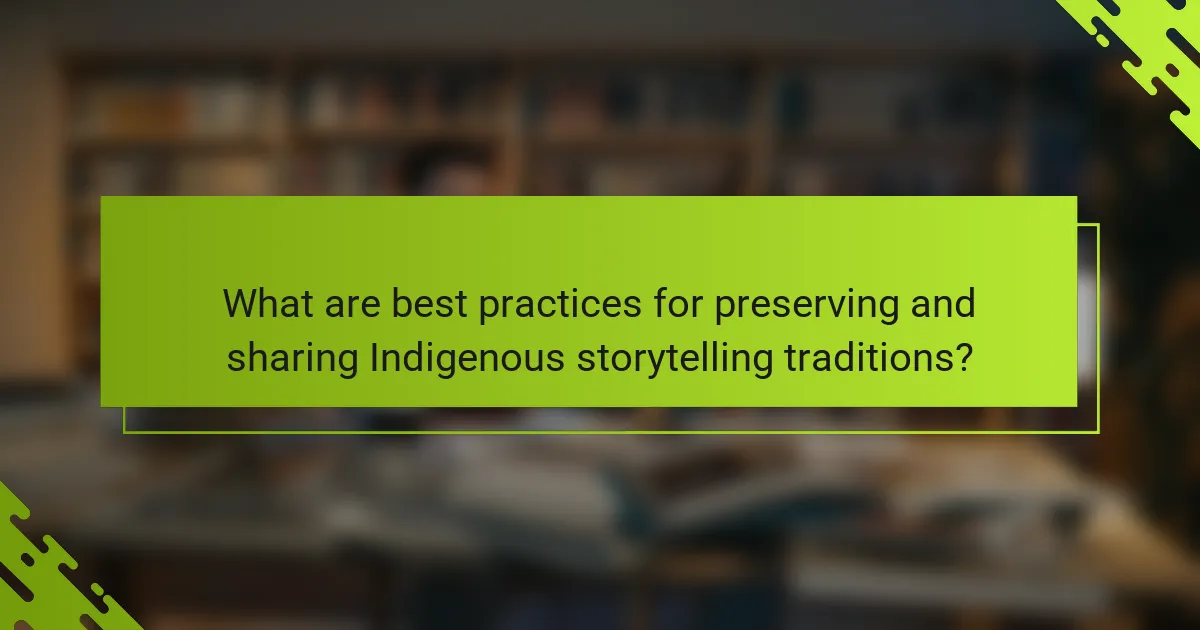
What are best practices for preserving and sharing Indigenous storytelling traditions?
To preserve and share Indigenous storytelling traditions, engage communities, respect cultural protocols, and utilize diverse media. Collaborative storytelling fosters authenticity and connection.
1. Involve Indigenous storytellers in the process to ensure accuracy and respect.
2. Record stories using audio or video to reach wider audiences.
3. Create educational programs that highlight storytelling’s cultural significance.
4. Promote intergenerational storytelling to keep traditions alive.
5. Utilize social media platforms to share stories and engage younger audiences.
How can communities engage youth in storytelling practices?
Communities can engage youth in storytelling practices by incorporating Indigenous storytelling traditions. These traditions emphasize oral narratives that connect young people to their cultural heritage and identity.
Incorporating storytelling workshops allows youth to learn traditional forms, such as legends, myths, and personal anecdotes. This interaction fosters creativity and encourages youth to express their experiences through storytelling.
Additionally, utilizing themes from Indigenous stories, such as respect for nature and community values, can resonate with youth. This relevance enhances their engagement and understanding of cultural significance.
Collaboration with Indigenous elders and storytellers provides mentorship opportunities. This guidance enriches youth storytelling skills and deepens their connection to cultural practices.
What resources are available for learning about Indigenous storytelling?
Numerous resources are available for learning about Indigenous storytelling. Books, documentaries, online courses, and workshops offer insights into the diverse forms and themes of these traditions.
Books such as “The Truth About Stories” by Thomas King and “Storytelling for Social Change” by the Center for Story-Based Strategy provide foundational knowledge. Documentaries like “In the Spirit of Crazy Horse” explore historical narratives and cultural significance. Online platforms such as Coursera and edX feature courses on Indigenous cultures and storytelling techniques. Local Indigenous communities often host workshops, allowing for direct engagement and learning from traditional storytellers.
These resources collectively enhance understanding of Indigenous storytelling, highlighting its cultural importance and unique attributes.
Which strategies can enhance the visibility of Indigenous narratives?
Utilizing diverse strategies can significantly enhance the visibility of Indigenous narratives. Engaging storytelling formats, such as oral traditions and multimedia presentations, can capture wider audiences. Collaborating with Indigenous creators ensures authenticity and representation. Leveraging social media platforms increases outreach and fosters community engagement. Educational programs that integrate Indigenous perspectives can raise awareness and appreciation.
